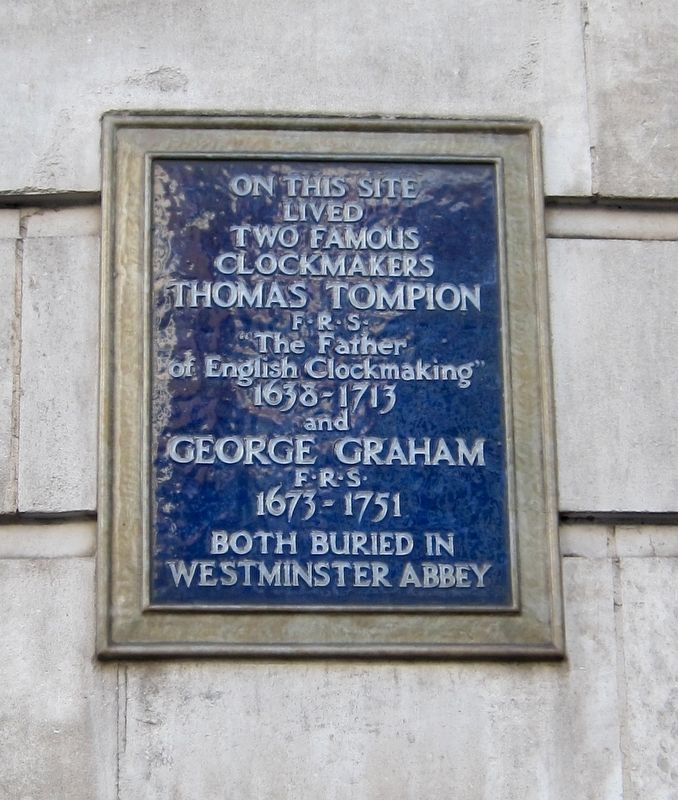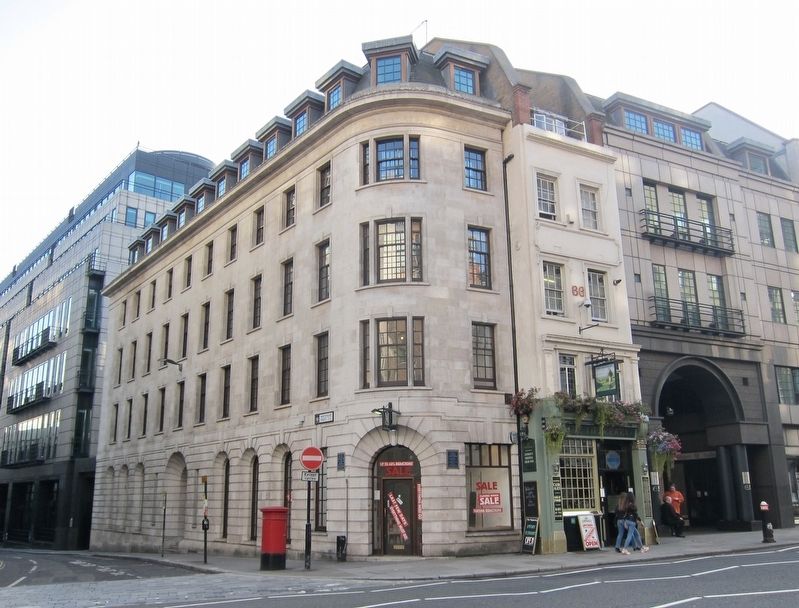City of London in Greater London, England, United Kingdom — Northwestern Europe (the British Isles)
Two Famous Clockmakers
lived
two famous
clockmakers
Thomas Tompion
F·R·S·
"The Father
of English Clockmaking"
1638-1713
and
George Graham
F·R·S·
1673-1751
Both buried in
Westminster Abbey
Topics. This historical marker is listed in these topic lists: Industry & Commerce • Science & Medicine.
Location. 51° 30.85′ N, 0° 6.454′ W. Marker is in City of London, England, in Greater London. Marker is at the intersection of Fleet Street and Whitefriars Street, on the left when traveling west on Fleet Street. Touch for map. Marker is at or near this postal address: 66 Fleet Street, City of London, England EC4Y 1HT, United Kingdom. Touch for directions.
Other nearby markers. At least 8 other markers are within walking distance of this marker. Anti-Corn-Law League (here, next to this marker); The Tipperary (here, next to this marker); The Daily Express (a few steps from this marker); Bolt Court (a few steps from this marker); All the Year Round, conducted by Charles Dickens (within shouting distance of this marker); The Standard (within shouting distance of this marker); Ye Olde Cheshire Cheese (within shouting distance of this marker); St. Dunstan's Court (within shouting distance of this marker). Touch for a list and map of all markers in City of London.
Also see . . .
1. Thomas Tompion (Wikipedia). "Thomas Tompion (1639–1713) was an English clockmaker, watchmaker and mechanician who is still regarded to this day as the Father of English Clockmaking. Tompion's work includes some of the most historic and important clocks and watches in the World and can command very high prices whenever outstanding examples appear at auction. A plaque commemorates the house he shared on Fleet Street with his equally famous pupil and successor George Graham....As England's most prominent watchmaker, Tompion's workshop built about 5,500 watches and 650 clocks during his career. Tompion's clocks are known for their ingenuity of design and robust construction. His three-train grande sonnerie bracket clocks are masterpieces. Those interested in mechanics are particularly attracted to the mechanisms of such clocks and his repeating watches as they are quite complex, indeed it could even be said over-complex, though efficient in operation. He shares this characteristic with the later French-Swiss watchmaker Breguet....Another of Tompion's innovations was to create a numbering system for his spring and longcase clocks, which is thought to be the first time that a serial numbering system was applied to manufactured goods." (Submitted on December 19, 2017.)
2. George Graham (clockmaker) (Wikipedia)
. "George Graham (7 July 1673 – 20 November 1751) was an English clockmaker, inventor, and geophysicist, and a Fellow of the Royal Society....Graham was partner to the influential English clockmaker Thomas Tompion during the last few years of Tompion's life. Graham is credited with inventing several design improvements to the pendulum clock, inventing the mercury pendulum and also the orrery....He was widely acquainted with practical astronomy, invented many valuable astronomical instruments, and improved others....His major contribution to geophysics was the discovery of the diurnal variation of the terrestrial magnetic field in 1722/23. He was also one of the first to notice long-term secular change in the direction of the compass needle...." (Submitted on December 19, 2017.)
Additional keywords. horology
Credits. This page was last revised on January 27, 2022. It was originally submitted on December 19, 2017, by Andrew Ruppenstein of Lamorinda, California. This page has been viewed 319 times since then and 16 times this year. Photos: 1, 2. submitted on December 19, 2017, by Andrew Ruppenstein of Lamorinda, California.

